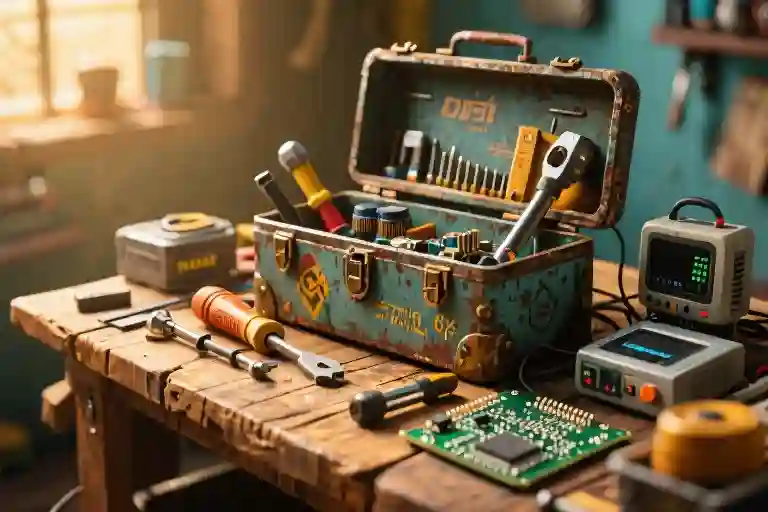The soldering iron trembled in my grip as acrid smoke curled from the circuit board. Around me, the lab hummed with success – blinking LEDs, satisfied murmurs, the rhythmic clicking of multimeters. My own project lay dead under the harsh fluorescent lights, a $3.87 failure that somehow weighed more than all the televisions I’d fixed back home combined.
My left thumb automatically rubbed against my index finger, the calloused patch where I’d burned myself last summer repairing Mrs. Sharma’s antique radio. The familiar sting used to ground me, a physical reminder that I could solve problems with these hands. Now it just highlighted the disconnect between the boy who could resurrect any broken appliance in Bihar and the engineering student staring at a nonfunctional PCB.
The iPhone in my lab coat pocket buzzed insistently. I knew without looking it would be Dad’s daily check-in, his contact photo showing me bent over our dining table at 14, triumphantly holding up the innards of our resurrected CRT television. That image had been his lock screen for four years, ever since I’d fixed our only working fan during the brutal May heatwave.
A classmate’s successful power-up sequence beeped to my right, the cheerful chirp of a functioning Arduino. The sound transported me to monsoon evenings in Patna, where I’d diagnose faulty wiring to the soundtrack of neighborhood kids playing cricket in the rain. Back then, failure wasn’t an option – not when the alternative meant Uncle Prabhu missing his evening news or Auntie Meena’s sewing machine sitting idle during wedding season.
The oscilloscope before me showed a flatline where there should have been dancing waveforms. I watched my reflection warp in its darkened screen, the face looking back simultaneously older and far less capable than the boy in Dad’s cherished photo. My toolkit – the same one that had earned me the nickname “Circuitwallah” at home – sat useless beside imported equipment I barely understood.
Somewhere beneath the scent of melting solder and isopropyl alcohol, I caught the faintest whiff of jasmine. Probably just memory filling in details from home, where Ma always kept fresh flowers by my repair station. The incongruous sensory ghost made my throat tighten. Engineering school wasn’t supposed to feel this lonely, this… fraudulent.
A cold droplet hit the back of my hand. For one absurd moment I thought I might be crying, until I recognized condensation from the lab’s overworked AC unit. Outside, a real Delhi monsoon was brewing, the kind that used to send neighbors rushing to my door with waterlogged appliances. Here in this sterile lab, no one would dream of asking me to fix so much as a loose connection.
When the Oscilloscope Became a Mirror
The soldering iron hovered mid-air as the acrid scent of burnt rosin filled my nostrils. On the lab bench, my circuit board lay motionless – a graveyard of carefully placed components that refused to cooperate. Around me, a symphony of successful projects played out: LEDs blinking in rhythmic patterns, servos humming obediently, the occasional cheer when someone’s code finally compiled. My own oscilloscope screen, which minutes ago had danced with beautiful sine waves, now showed only a flatline.
Sweat made the screwdriver slippery in my palm. I counted twelve visible solder joints, each one perfect under the magnifying glass. Yet the stubborn LED remained dark, mocking three hours of meticulous work. This wasn’t supposed to happen – not to me, the boy from Gaya who could diagnose a faulty television just by listening to its power-on hum.
A memory flashed: monsoon rains pounding our tin roof during last year’s India-England cricket match. Our neighborhood’s collective groan when Mr. Sharma’s prized Samsung TV flickered out during Kohli’s century. The way everyone turned to me, the sixteen-year-old who understood electricity like others understood cricket scores. Back then, solutions came instinctively – a replaced capacitor here, a resoldered connection there. Now, in this pristine engineering lab, my hands felt foreign to me.
The teaching assistant’s voice cut through my thoughts: ‘Check your ground connections.’ But I already had. Twice. My classmates’ projects continued their cheerful blinking, each successful light a tiny dagger. The lab’s fluorescent lights reflected off my phone screen where my father’s favorite photo glared back at me – fourteen-year-old me triumphantly holding up the repaired radio that had earned me the nickname ‘Current Aniket’ in our mohalla.
Something fundamental had short-circuited between that monsoon-soaked veranda and this air-conditioned laboratory. The oscilloscope’s flat line wasn’t just a technical failure – it had become a mirror reflecting a crumbling identity. All those years of being the neighborhood’s tech whisperer hadn’t prepared me for this moment when, surrounded by textbooks and lab equipment, my intuitive understanding met its match.
A classmate’s servo motor whirred to life, its precise movements a stark contrast to the chaos in my mind. I stared at the dead circuit board, seeing not just failed connections but the fragile wiring of my own technical confidence beginning to fray.
Circuit Autopsy: Tracing the Fractures in My Confidence
The soldering iron slipped from my sweaty grip as I stared at the silent circuit board. My classmates’ projects beeped and blinked around me – a cruel symphony of success. I ran through the mental checklist every electronics hobbyist knows: power supply? Check. Component orientation? Verified. Soldering joints? They looked… questionable.
The Fault Tree That Grew Roots
Methodically, I began constructing a fault tree in my lab notebook:
- Power delivery failure
- Multimeter confirmed 5V at regulator output
- Yet the LED remained dark as monsoon clouds
- Signal path interruption
- Continuity tests revealed three cold solder joints
- My hands, usually steady as temple carvings, had betrayed me
- Component mortality
- The 220Ω resistor measured infinite resistance
- Sacrificed to my haste, like so many diodes in childhood experiments
As the technical analysis progressed, something unexpected happened. The clinical detachment I’d learned from engineering textbooks began crumbling. Each measurement probe touching the board felt like poking at my own inadequacies.
The Ghost of Radios Past
The fluorescent hum of the lab dissolved into memory. Suddenly I was twelve again, squatting on the dirt floor of Mr. Sharma’s general store, his prized transistor radio spread before me like a patient awaiting surgery. That day, I’d diagnosed a loose speaker wire within minutes – the shopkeeper declaring me a ‘little genius’ to anyone who’d listen.
Now, holding my failed circuit, I realized something profound. Village electronics operated on different rules. There, success came from:
- Improvisation (using bicycle spokes as antennae)
- Persistence (testing every capacitor until the static cleared)
- Community knowledge (uncles arguing over tube amplifier designs)
Formal engineering demanded precision I hadn’t yet mastered. My hands knew the weight of a well-worn screwdriver, but trembled before surface-mount components. I could recite Ohm’s Law in my sleep, yet couldn’t explain why this simple circuit refused to cooperate.
The Bilingual Technician’s Dilemma
My professor’s voice broke through the reverie: ‘Aniket, have you checked your ground connections?’ The question carried layers beyond its technical surface. In that moment, I stood at the intersection of:
- Jugaad innovation (making broken things work through creative hacks)
- Academic rigor (following datasheets to the letter)
Back home, troubleshooting meant listening – to the crackle of a dying amplifier, the whine of an overloaded transformer. Here, solutions lived in oscilloscope waveforms and mathematical models. Both valid, yet speaking different technical languages.
As I resoldered the faulty joints, a new understanding took shape. Perhaps real engineering mastery wasn’t about choosing between these worlds, but becoming fluent enough to translate between them – to know when a problem needed village intuition or laboratory methodology. The LED flickered to life just as the lunch bell rang, its glow weaker than designed but undeniably alive. Like my emerging identity as an engineer, it wasn’t perfect… but it was working.
The Toolbox Dialogues
The smell of burnt plastic still clung to my fingers as I stared at the stubbornly dark circuit board. In that moment of failure, my mind flashed to another toolbox – the battered metal case back home in Bihar, its hinges squeaking with the weight of generations. That toolbox didn’t contain precision multimeters or temperature-controlled soldering stations, just a collection of well-worn screwdrivers, a cracked magnifying glass, and my father’s vintage multimeter with its needle that always stuck at 50 ohms.
The Village Repair Shop
Monsoon rains pounding on corrugated tin roofs. The collective groan when the television flickered during crucial cricket matches. My small hands reaching for the screwdriver before the adults could finish their requests. These memories play in my mind like a grainy VHS tape, each repair job stitching another patch onto my identity as ‘the fixer’.
I remember Uncle Sharma’s radio – a 1970s Grundig that crackled like frying pakoras. While engineering textbooks would later teach me about impedance matching, twelve-year-old me learned by twisting the variable capacitor until the static cleared just enough to hear Lata Mangeshkar’s voice emerge like a butterfly from its cocoon. Those successes came through trial, error, and something my father called ‘circuit intuition’ – a quality no engineering syllabus could quantify.
The Multimeter Between Generations
Father’s analog multimeter sits on my dorm desk now, its cracked Bakelite casing holding more wisdom than my entire circuits textbook. This device measured more than voltage and current – it measured the space between his practical know-how and my theoretical learning. When he handed it to me before I left for college, he said, ‘This needle has seen more short circuits than your professors.’ At the time, I took it as a joke. Now I understand it as a warning.
In our video calls home, I notice how his eyes glaze over when I mention Fourier transforms or PCB design software. His questions always return to the tangible: ‘Did you check the solder joints? Is the battery fresh?’ Our technical languages have diverged, his rooted in the tactile reality of repair, mine increasingly abstracted into simulation software and ideal components that don’t exist outside textbooks.
When Knowledge Systems Collide
The fracture became undeniable during last summer’s visit home. Our neighbor brought a malfunctioning mixer-grinder, and for the first time, I reached for the service manual instead of instinctively probing the circuit. Father watched silently as I traced schematic diagrams while the impatient tapping of the neighbor’s foot marked time. Later, he quietly fixed it by replacing a worn carbon brush – a solution nowhere in the official troubleshooting guide.
That moment crystallized the cultural short circuit I’m experiencing. My engineering education values systematic approaches, documented procedures, and standardized solutions. The village ecosystem that shaped my technical identity operates on heuristic knowledge, adaptive reuse, and solutions born from scarcity (what Indians call ‘jugaad’). Neither approach is wrong, but their collision in my mind leaves sparks that no textbook explains how to extinguish.
Rewiring the Connection
Back in the lab, my failed circuit board mocks me with its silence. I reach for the modern digital multimeter, then pause. Slowly, I unpack father’s old analog device. Its needle wavers uncertainly at first, just like my current technical identity. But as I methodically check each component – not just with the instruments, but with fingers that remember the texture of good solder joints – something remarkable happens.
The solution emerges not from the pristine lab manual, nor from pure village intuition, but in the dialogue between them. A cold solder joint invisible to the eye reveals itself to touch. The textbook’s bypass capacitor recommendation combines with remembered tricks about stabilizing oscillators. When the LED finally flickers to life, its light illuminates both toolboxes – the one filled with precision instruments, and the one carrying generations of accumulated wisdom.
Perhaps technical mastery isn’t about choosing between these worlds, but learning to be bilingual in their respective languages. The real short circuit wasn’t in my project board, but in my assumption that these knowledge systems couldn’t coexist. As I pack up my tools, I make a mental note to ask father about those carbon brushes – not just how they work, but how he learned to listen to what machines whisper when they’re failing.
Calibrating the Mental Oscilloscope
The moment my multimeter showed infinite resistance where there should have been a clean 5V reading, my hands developed their own tremors. In engineering school, we’d learned to calculate voltage drops and current flows, but nobody taught us how to measure the psychological impedance when confidence shorts out. That’s when I developed the Failure Quadrant model – not on graph paper, but in the smudged margins of my lab notebook during those long nights troubleshooting.
The Four Quadrants of Technical Distress emerged from observing how different failures affect learners:
- Toolset Tantrums (lower left): When your equipment betrays you – like the soldering iron that chose that crucial moment to overheat. The fix is mechanical, but the frustration feels personal.
- Knowledge Blackouts (upper left): That sickening realization when the circuit diagram might as well be Sanskrit. Where theory and practice refuse to interface.
- Identity Short Circuits (lower right): When failing at a task makes you question if you’re still the person who fixed Uncle’s radio during monsoon season.
- Cultural Ground Loops (upper right): The humiliating awareness that your village repair tricks don’t impress professors who speak in differential equations.
I created an Engineer’s Emotional Color Code after noticing how my oscilloscope’s traces mirrored my moods:
- Red: Frustration spikes (like clipping distortion)
- Blue: Analysis paralysis (flatlining curiosity)
- Green: Slow understanding (rising sawtooth of hope)
- Yellow: Eureka moments (perfect sine waves)
The lab’s constant 60Hz hum would sometimes phase-shift into memories – the crackle of our village’s overtaxed generator, the particular static of Doordarshan news broadcasts during thunderstorms. These auditory ghosts made me realize technical thinking isn’t sterile; it’s always accompanied by the background noise of personal history.
What saved me was treating my mind like a misbehaving circuit – applying the same patience I’d give to a balky transistor radio. Sometimes you need to walk away (let the capacitors discharge). Other times, you change your measurement approach (switch from DC to AC coupling). The tools were different, but the mindset carried over – once I stopped seeing failure as betrayal and started treating it as diagnostic data.
That’s when the real calibration began. Not of instruments, but of expectations. The oscilloscope’s graticule became a grid for plotting progress, not perfection. Each failed experiment left behind something more valuable than a working circuit – the ability to distinguish between a dead end and a difficult path forward.
Rewiring: The Fault-Driven Learning Method
The LED finally flickered to life on my fifth attempt, its erratic glow casting jagged shadows across the lab bench. This wasn’t the triumphant moment I’d imagined – the light pulsed unevenly, sometimes dimming to near darkness before surging again. My professor leaned over my shoulder and surprised me by saying, “Now this is interesting.”
The Five-Step FDL Framework
- Fault Isolation (Identify the exact point of failure)
- That first dark circuit board taught me to stop assuming entire systems were broken. Using the divide-and-conquer method from computer science, I learned to test each segment separately. The problem wasn’t my entire design, just one improperly seated voltage regulator.
- Cultural Translation (Bridge practical knowledge with theory)
- My village repairs relied on pattern recognition (“the TV makes this sound when capacitors fail”), while engineering demanded mathematical modeling. I created a personal glossary translating empirical observations into technical terms – what we called “ghost signals” became electromagnetic interference.
- Controlled Breakdown (Intentionally induce failures)
- My father’s generation believed good work never breaks. But I started building circuits designed to fail in specific ways – removing resistors to observe current spikes, creating short circuits to study protection mechanisms. These planned disasters built my diagnostic intuition.
- Tool Hybridization (Combine traditional and modern approaches)
- I keep two toolkits: my university’s digital multimeter alongside my grandfather’s analog tester with its wavering needle. The old tools often reveal what precision instruments miss – like how a slightly warm transformer tells stories no thermal camera can capture.
- Documented Recovery (Record each repair journey)
- My engineering notebook now includes not just schematics, but emotional states. A coffee stain marks the page where I nearly quit, while a smudged pencil diagram shows the moment I realized some connections work better when slightly imperfect.
The Cultural Circuit Library
In my dorm, I maintain what friends call the “Jugaad Museum” – a collection of hybrid solutions:
- A motorcycle battery repurposed as a lab power supply
- Textbook circuits modified with local component substitutions
- Failed prototypes with their autopsy reports
Each item demonstrates how technical knowledge morphs across cultural contexts. The museum’s centerpiece is that first non-working circuit board, now framed with a plaque: “This darkness taught me to see.”
The Metaphor of Light
That final project didn’t produce the steady glow I’d envisioned. But as the irregular pulses reflected off my professor’s glasses, I understood something fundamental – consistent brightness is for store-bought bulbs. Real engineering lives in the flickers, the recoveries, the moments when everything nearly goes dark before surging back, stronger for having stumbled.
Now when I see students struggling with their first failures, I show them my erratic LED and tell them: “Good circuits breathe. Perfect ones are usually dead.”
The Flickering Epilogue
The LED finally flickered to life, but not in the way I’d imagined. Its glow pulsed irregularly across the workbench, casting jagged shadows that danced over my father’s old toolbox. The oscilloscope screen showed waveforms that would make any engineer cringe – unstable, imperfect, yet undeniably alive. In that erratic pulse, I saw the reflection of every repair job in Bihar, every botched experiment in the lab, every moment I’d spent straddling two worlds of engineering.
As the light hit a grease-stained photograph tucked inside the toolbox – my father at twenty, rewiring a village generator during monsoon season – something shifted. The failures suddenly made sense in a way the successes never had. That generator had powered our village through three blackout seasons before finally giving out, its parts cannibalized to keep other machines running. Imperfect solutions for an imperfect world.
My professor walked by and paused at the unstable waveform. ‘Interesting harmonics,’ he remarked. Not ‘wrong.’ Not ‘failed.’ Just… interesting. The LED’s glow projected my father’s photo onto the lab wall, superimposing his younger face over circuit diagrams and safety notices. Two generations of problem-solvers, one working with whatever scraps the village could afford, the other with precision instruments that measured voltage down to the millivolt.
I realized then that engineering wasn’t about maintaining perfect waveforms. The village repairs that built my reputation were all improvisations – transistor radios kept alive with paperclips and prayer, television antennas weighted with rusted bolts. Our family’s toolbox contained three generations of makeshift solutions: my grandfather’s hand-filed wrenches, my father’s recycled components, and now my digital multimeter. Each tool told the same story – technology survives through adaptation, not perfection.
When I packed up that evening, I left the LED circuit as it was – imperfectly functional. The oscilloscope still showed erratic patterns, but now I recognized them as the signature of real-world electronics. No textbook had prepared me for this truth: circuits, like the engineers who build them, are allowed to be messy. That unstable waveform wasn’t a failure; it was the system responding to conditions no simulation could predict.
My father called as I walked home. ‘How was the lab?’ he asked. Through the phone, I could hear Sahil and Alok arguing over a disassembled toy in the background. ‘The LED works,’ I said, ‘but the waveform looks terrible.’ He laughed – the same laugh I’d heard when our roof leaked during monsoon and he jury-rigged a drainage system from plastic bottles. ‘Good,’ he said. ‘Now you’re doing real engineering.’
The toolbox stays open.





